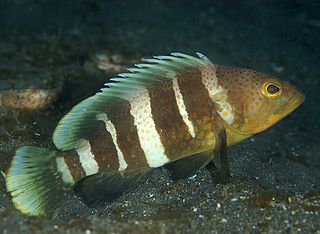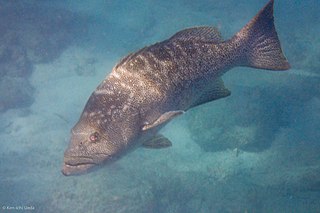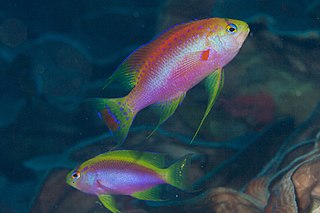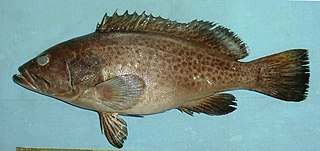
The Hong Kong grouper is a species of marine ray-finned fish, a grouper from the subfamily Epinephelinae which is part of the family Serranidae, which also includes the anthias and sea basses. It is found in eastern and southeastern Asian waters of the Western Pacific Ocean. Its natural habitats are shallow seas and coral reefs.

Epinephelus albomarginatus, the white-edged grouper, white-edged rockcod or captain fine, is a species of marine ray-finned fish, a grouper from the subfamily Epinephelinae which is part of the family Serranidae, which also includes the anthias and sea basses. It is found in the southwestern Indian Ocean and it is associated with coral reefs. It is a target species for commercial and recreational fisheries.

The yellow grouper, also known as the banded grouper, is a species of marine ray-finned fish, a grouper from the subfamily Epinephelinae which is part of the family Serranidae, which also includes the anthias and sea basses. It is found in eastern Asian waters of the Western Pacific Ocean. Its natural habitats are shallow seas and rocky reefs.

Cephalopholis miniata, also known as the coral grouper, coral hind, coral rock cod, coral cod, coral trout, round-tailed trout or vermillion seabass is a species of marine ray-finned fish, a grouper from the subfamily Epinephelinae which is in the family Serranidae which also includes the anthias and sea basses. It is associated with coral reefs and occurs in the Indo-Pacific.

Pseudanthias bartlettorum, Bartlett's anthias is a species of marine ray-finned fish in the subfamily Anthiinae of the family Serranidae, the groupers and sea basses. It occurs in the Pacific Ocean. This fish is sometimes kept in aquaria.

Pseudanthias bicolor, the bicolor anthias or yellowback basslet is a species of marine ray-finned fish from the subfamily Anthiinae of the family Serranidae, the groupers and sea basses. It is from the Indo-Pacific Ocean. It occasionally makes its way into the aquarium trade. It grows to a size of 13 cm in length.

Pseudanthias parvirostris, the sunset anthias is a species of marine ray-finned fish in the subfamily Anthiinae of the family Serranidae, the groupers and sea basses. It is found in the Indo-West Pacific Ocean. It occasionally makes its way into the aquarium trade. It grows to a size of 7.5 cm in length.

Pseudanthias rubrizonatus, the red-belted anthias, liliac-tip basslet, deepsea fairy basslet, lilac-tipped seaperch, redband anthias, red-band basslet or redbar anthias is a species of marine ray-finned fish, an anthias from the subfamily Anthiinae part of the family Serranidae, the groupers and sea basses. It is found in the Indo-Pacific. It occasionally makes its way into the aquarium trade. It grows to a size of 12 cm in length.

Pseudanthias pleurotaenia also known as the squarespot anthias, pink square anthias, mirror basslet or squarespot fairy basslet is a species of marine ray-finned fish in the subfamily Anthiinae of the family Serranidae, the groupers and sea basses. This species of Pseudanthias is a reef dwelling fish of the Pacific Ocean. It occasionally makes its way into the aquarium trade and grows to a size of 20 cm in length. The males are deep pink and orange in colour with a large quadrilateral purplish blotch on the flank, a red tip on the posterior margin of the dorsal fin, the caudal fin lobes have mauve tips and there is a reddish stripe which runs from the snout through the eye and through the base of the pectoral fin to the base of the tail. Females and juveniles are yellowish in colour with orange edges to their scales and they have two purple stripes which run from the eye along the lower flanks to the base of the tail.

Cephalopholis taeniops, the African hind, bluespotted sea bass or spotted grouper, is a species of marine ray-finned fish, a grouper from the subfamily Epinephelinae which is in the family Serranidae which also includes the anthias and sea basses. This species occasionally makes its way into the aquarium trade and is a target for local fisheries. It is found in the eastern Atlantic Ocean.

Cephalopholis fulva, the coney or the butterfish, is a species of marine ray-finned fish, a grouper from the subfamily Epinephelinae which is in the family Serranidae which also includes the anthias and sea basses. It is found in the western Atlantic. It is associated with reefs and is a quarry species for commercial and recreational fisheries. It can be found in the aquarium trade.

Cephalopholis spiloparaea, known commonly as the strawberry hindstrawberry rock cod, strawberry cod or orange rock cod, is a species of marine ray-finned fish, a grouper from the subfamily Epinephelinae which is in the family Serranidae which also includes the anthias and sea basses. This fish occurs throughout the Indo-Pacific region.

Epinephelus flavocaeruleus, commonly called blue-and-yellow grouper, is a species of marine ray-finned fish, a grouper from the subfamily Epinephelinae which is part of the family Serranidae, which also includes the anthias and sea basses. It is associated with reefs in the Indian Ocean.

Mycteroperca rosacea, the leopard grouper or golden grouper, is a species of marine ray-finned fish, a grouper from the subfamily Epinephelinae which is part of the family Serranidae, which also includes the anthias and sea basses. It is found in the Eastern Central Pacific that occasionally makes its way into the aquarium trade.

Pseudanthias ventralis, the longfin anthias or longfin basslet', is a species of marine ray-finned fish, an Pseudanthias from the subfamily Anthiinae part of the family Serranidae, the groupers and sea basses. It is found in the Western Pacific Ocean.

Cephalopholis sexmaculata, sixblotch hind, freckled cod, freckled rock-cod, sixband cod, six-banded rockcod, sixband rockcod or sixspot rockcod is a species of marine ray-finned fish, a grouper from the subfamily Epinephelinae which is in the family Serranidae which also includes the anthias and sea basses. This fish occurs throughout the Indo-Pacific region.

Pelvicachromis sacrimontis is a freshwater fish of the cichlid family known only from a small area of southeastern Nigeria. Currently Fishbase considers this binomial to be a junior synonym of P. pulcher and, it was also known as Pelvicachromis camerunensis, P. pulcher "form B" or P. sp. aff. pulcher but some authorities now consider it to be a valid species. It is occasionally available in the tropical fish trade as "giant krib" and there are three colour morphs – red, green and yellow. And are the most colorful of the Pelvicachromis family. Today its popularity increases due to more order demands by aquarium hobbyists.

Epinephelus sexfasciatus, the sixbar grouper, sixbar rockcod or six-banded rockcod, is a species of marine ray-finned fish, a grouper from the subfamily Epinephelinae which is part of the family Serranidae, which also includes the anthias and sea basses. It is found in the Indo-Pacific region.
'Pseudanthias ignitus, the flame anthias or flame basslet is a species of marine ray-finned fish, an anthias from the subfamily Anthiinae part of the family Serranidae, the groupers and sea basses. It is found in the Indo-Pacific region.

Epinephelus bleekeri, the duskytail grouper, Bleeker's grouper or Bleeker's rockcod, is a species of marine ray-finned fish, a grouper from the subfamily Epinephelinae which is part of the family Serranidae, which also includes the anthias and sea basses. It is found in the Indo-Pacific region where it is associated with shallow banks.
Schuhmacher, H., F. Krupp and J.E. Randall, 1989. Pseudanthias heemstrai, a new species of anthiine fish (Perciformes: Serranidae) from the Gulf of Aqaba, Red Sea. Fauna of Saudi Arabia 10:338-346.


















